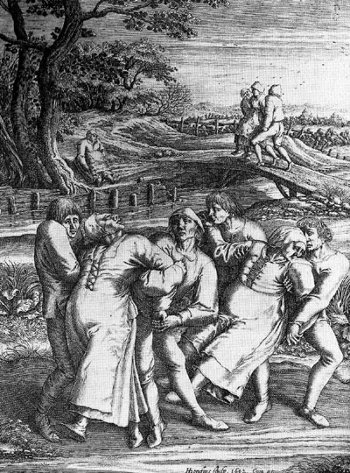
In July 1518, a woman named Frau Troffea stepped into a street in Strasbourg and began to dance. As onlookers gathered it became clear that she could not stop; after many hours of exertion she collapsed and slept briefly but then rose and again began the dance. After three exhausting days she was bundled into a wagon and taken to a shrine in the Vosges Mountains, but her example had had its effect. Within days more than 30 more people had begun to dance uncontrollably, and their numbers grew; according to one chronicle, within a month 400 people were dancing.
The fact of the plague is well attested; a manuscript chronicle in the city’s archives reads:
There’s been a strange epidemic lately
Going amongst the folk,
So that many in their madness
Began dancing,
Which they kept up day and night,
Without interruption,
Until they fell unconscious.
Many have died of it.
The sickness lasted until early September, when it passed away just as mysteriously. A number of explanations have been put forward, including convulsion brought on by ergot, a mold that flourishes on the stalks of damp rye. The most convincing was advanced by John Waller in his 2008 book A Time to Dance, A Time to Die: He found that a series of famines had preceded the dancing plague, spreading fear and anxiety through the city, and that a Christian church legend had told that a wrathful Saint Vitus would send down plagues of compulsive dancing on anyone who angered him. The dancing, Waller believes, was a “mass psychogenic illness” brought on by this belief.
Vanderbilt epidemiologist Timothy Jones says the plague is “of immense historical value”; it “tells us much about the extraordinary supernaturalism of late medieval people, but it also reveals the extremes to which fear and irrationality can lead us.”
